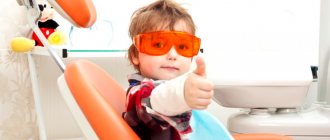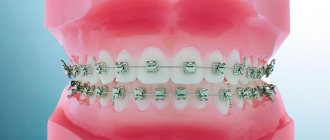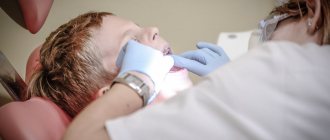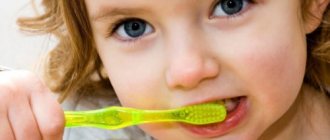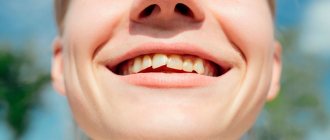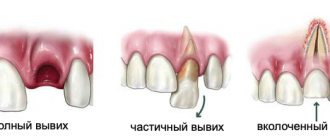What are molars?
They are formed from the epithelial dental plate: molar rudiments appear only by the fifth month of the mother’s pregnancy. They are divided into two types: replacement - incisors, canines and molars, and additional - molars. The first ones repeat similar teeth in the “milk” set, the second ones have no predecessors.
The rudiments of replacement molars grow in the same alveolus as milk teeth, behind the lingual surface, and over time they are isolated by bone tissue. The rudiments of additional ones are formed only after a year, since the jaw by that time increases in size.
Parents helping their child when his molars are being cut
The process of erupting molars is long and painful. During these periods, parents should try to be very attentive and tolerant towards their baby. To reduce pain and anxiety, pediatric dentists recommend using special gels that are cooled in teethers.
If your temperature rises or alarming symptoms such as runny nose or cough appear, you should definitely consult a pediatrician. The doctor will determine the exact cause and may prescribe anti-inflammatory drugs.
Teething is a period when increased attention to oral hygiene is required. For this age, you need to choose the right toothpaste for your child. For example, children's toothpaste from the ASEPTA baby series for children aged 0 to 3 years significantly reduces the number of harmful microbes in the child's mouth, so that the difficult period of teething passes without unnecessary hassle.
What permanent teeth should children have at different ages?
On average, the timing of eruption does not vary much. In hotter climates this process occurs faster:
- Central incisors - make themselves felt in the period from 5-7 to 6-9 years.
- Lateral - a little later, from 7 to 10-11 years.
- Fangs - on average appear at 12-13 years of age (some experts expand this range to 9-14).
- First premolars - can appear between the ages of 9 and 12-13 years.
- Second premolars – opinions differ regarding these teeth: 9-11, 9-15, 10-14 years.
- First molars are among the earliest: from 5 to 8 years.
- Second molars - in the period from 10 to 15 years, but more often at 12-13 years.
- Third molars - after 18 years (according to various sources, up to 20-25 years).
Researchers give different timing of eruption, since they rely on results from different regions, with different climates, which greatly influences the replacement process.
How many primary and molar teeth does a person have?
In children, the size of the jaw is almost half (in terms of the number of teeth that fit on it) smaller than in adults. Initially, the child has up to 20 teeth - 10 on each jaw. That is, one jaw - 4 incisors, 2 canines and 4 molars. Primary molars have not yet been clearly divided into small and large.
After 16 years, a teenager’s jaws reach approximate sizes that are accessible to an adult. A teenager already has approximately 28-30 teeth, and not 20-24, as before. The number of molars is often represented by 2 small molars and 2 large molars - on each side on each jaw. The last 2 or 4 teeth - “wisdom teeth” usually appear by the age of 20-22 - and a person acquires a full set of teeth, numbering 8 incisors, 4 canines, 8 small molars and 12 large molars - on both jaws in total.
How many teeth change in children: order of eruption
During the replacement process, the child loses all twenty baby teeth, and 32 permanent teeth grow to replace them. Very often, the child first grows the first molars, which are absent in the primary dentition, and not the central incisors, as is commonly believed. In the future the sequence is as follows:
- lower, and behind them upper incisors in the center of the jaw;
- lateral incisors located above and below;
- 1st premolars;
- fangs;
- 2nd premolars;
- The 2nd and 3rd molars (“wisdom teeth” may never arrive).
It is not by chance that this sequence is laid down by nature. It takes into account the growth rate of the jaw and skull bones, which means that if the order is followed, the correct bite is formed.
What parents should pay attention to
The body prepares for the eruption of milk teeth in infants in advance. Therefore, the first signs are quite easy for mothers and fathers to identify on their own, as the child’s emotional state changes, he is capricious, sleeps poorly, and puts toys in his mouth. In addition, the baby has:
- excessive salivation
- swelling and redness of the gums, accompanied by itching
- increase in body temperature
- loss of appetite
All these symptoms usually disappear after the tooth erupts.
How does the growth process of molars occur?
At 12-13 years of age, a child, as a rule, no longer has milk teeth, although their roots dissolve earlier. At this point, there are part of the molars in the mouth with fully and partially formed roots.
Dental roots go through 2 stages in their development:
- the period of unformed apex (the root is still as long as possible, the walls are parallel, the canal is wide);
- the stage of an unclosed apex (the formation of the apex ends, the walls of the canal come closer together).
The roots of the lower jaw form faster than the upper jaw. This process also has approximate deadlines, but they can shift in both directions. Therefore, it is definitely impossible to answer the question at what age children develop permanent teeth - canines, incisors or molars. As with dairy products, everything is individual here.
Timing of eruption
As a rule, it is almost impossible to determine the exact time of eruption of milk teeth in infants, since the process occurs individually for each child and depends not only on his state of health and genetic characteristics of the body, but on the health of the mother during pregnancy.
Usually the baby's lower central incisors appear first, then the upper central incisors begin to grow. All baby teeth in a child erupt before the age of 2.5–3 years.
According to research, the optimal pattern for teething in infants is as follows:
- 6–9 months – lower central incisors
- 7–10 months – central upper incisors
- 9–12 months – lateral upper and lower incisors
- 12–18 months – upper molars
- 13–19 months – lower molars
- 16–20 months – upper canines
- 17-22 months – lower canines
- 20-33 months - second lower molars
- 24-36 months - second upper molars
How long do permanent teeth grow?
There are no exact dates for the growth of permanent teeth; in each case, individual characteristics of the body and hereditary factors play a role.
Time frame for the final formation of the root system of molars:
- incisors located in the center - climb by 10 years;
- lateral incisors - by 10 years;
- fangs - by the age of 13;
- first premolars - emerge by age 12;
- second premolars – 1 to 12 years;
- first molars – by 10 years;
- second molars are cut by the age of 15.
The rate of tooth growth is different for each group. Rapid eruption is observed in the second premolars; in six months they rise by 8 mm. The incisors located in the center rise by 12 mm per year, and the canines grow to 13 mm in two years.
If there is a slight increase over a long period of time, you should see a doctor. Perhaps the child has problems related to the replacement of milk units.
How to determine that a child will soon have molars?
According to some of the signs, interdental intervals initially increase. This happens due to the growth of the jaw bones - the teeth begin to not fit tightly together, as happens in adults. Then the temporary teeth gradually become loose - due to the gradual disappearance of the temporary root, which can no longer reliably hold such a tooth, and itself is gradually pushed out of the soft and semi-soft tissues on the jaw. The loss of a temporary tooth is a clear sign that the permanent tooth is already growing in full force, and the top of its crown will soon push apart the gum tissue. The appearance of a new tooth is also accompanied by slight redness and swelling. If a child or teenager has a fever, their health has worsened, and their gums hurt, go to the doctor immediately.
Sequence of eruption of permanent teeth
Milk teeth have a weak root system, which begins to dissolve by the age of 7. Therefore, in addition to changing incisors and molars, a new bite is formed. Sequence of physiological process:
- from 6-7 years old the first molars appear;
- then, by the age of 7-8 years , the incisors located in the center are replaced;
- by the age of 8-9 years, the lateral primary incisors are renewed with permanent units;
- at 10-12 years of age the relay moves to the first premolars;
- permanent clicks replace milk predecessors closer to 9-11 years ;
- from 10-12 years of age, the second premolars erupt;
- by the age of 13, the second molars are formed;
- Third molars appear between the ages of 16 and 25 ; in some people they never appear.
Names of teeth for easy reference in tables.
Possible problems with deviations from the norm
Complete edentia is a case when teeth are completely absent.
Regardless of the fact that the molars have just appeared or are about to erupt in the mouth of their beloved child, parents should be vigilant, because there are many dental problems. The main issue is the delay in the growth of permanent teeth (a baby tooth has fallen out, but a new one has not appeared).
The reason may lie in a genetic predisposition or edentia, which arose due to a violation of the formation of rudiments during intrauterine development. If there is no way to influence the situation, the child is indicated for prosthetics.
When permanent teeth erupt, another problem may arise – pain. This is most often due to thin, not fully formed enamel, which does not have sufficient mineralization. It is at this stage that the tooth is susceptible to various diseases, in particular caries.
With deep destruction of dental tissues, even more serious diseases develop: pulpitis, periodontitis. Therefore, you cannot ignore a child’s toothache; you need to make an appointment with a pediatric dentist as soon as possible.
At the very beginning of the growth of permanent teeth, other problems can occur:
- loss of a root unit is a signal of serious problems with the child’s health;
- an increase in the level of trauma - the active lifestyle of children during the period of maturation of molars often leads to injury to the incisors and canines, and attempts to chew hard objects end in the breakage of molars and premolars.
Each case requires the intervention of a specialist to eliminate the negative consequences.
In what cases may they appear earlier/later and why?
If at least one tooth has grown by the age of one year, there is no reason to worry.
According to statistical data, in modern babies the period of eruption of the first teeth differs slightly from generally accepted normative indicators. White surfaces of the incisors are observed from 8.5 months of age.
Accordingly, the process of replacing dairy units with permanent units is also shifting. Pediatric dentists do not see any problems if by the age of one year the child has at least one tooth , and by the age of three the entire milk group has been formed.
In the complete absence of units, a thorough examination of the baby is carried out to identify provoking factors.
A discrepancy in the timing of teething may be due to a genetic factor or other reasons. Among the main provocateurs of process delays:
- previous infectious diseases;
- disruption of the gastrointestinal tract that occurred over a long period of time;
- problems with the metabolic functions of the body;
- lack of vitamin D (when diagnosing rickets);
- pituitary insufficiency.
It is not only the late teething that is alarming, but also their earlier appearance. Most often this occurs as a result of a disorder of the endocrine system (for example, Albright's syndrome, hyperthyroidism, hypergonadism).
A growing tumor (for example, eosinophilic granuloma) can provoke the eruption of one or a whole group of incisors before the age of six months.

